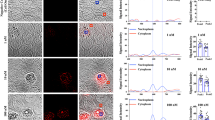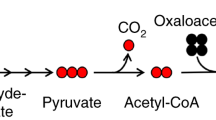Abstract
Cell-based assays for compound screening and profiling are fundamentally important in life sciences, chemical biology and pharmaceutical research. Most cell assays measure the amount of a single reporter molecule or cellular endpoint, and require the use of fluorescence or other labeled materials. Consequently, there is high demand for label-free technologies that enable multiple biomolecules or endpoints to be measured simultaneously. Here, we describe how to develop, optimize and validate MALDI-TOF mass spectrometry (MS) cell assays that can be used to measure cellular uptake of transporter substrates, to monitor cellular drug target engagement or to discover cellular drug-response markers. In uptake assays, intracellular accumulation of a transporter substrate and its inhibition by test compounds is measured. In drug response assays, changes to multiple cellular metabolites or to abundant posttranslational protein modifications are monitored as reporters of drug activity. We detail a ten-part optimization protocol with every part taking 1–2 d that leads to a final 2 d optimized procedure, which includes cell treatment, transfer, MALDI MS-specific sample preparation, quantification using stable-isotope-labeled standards, MALDI-TOF MS data acquisition, data processing and analysis. Key considerations for validation and automation of MALDI-TOF MS cell assays are outlined. Overall, label-free MS cell-based assays offer speed, sensitivity, accuracy and versatility in drug research.
This is a preview of subscription content, access via your institution
Access options
Access Nature and 54 other Nature Portfolio journals
Get Nature+, our best-value online-access subscription
$29.99 / 30 days
cancel any time
Subscribe to this journal
Receive 12 print issues and online access
$259.00 per year
only $21.58 per issue
Buy this article
- Purchase on Springer Link
- Instant access to full article PDF
Prices may be subject to local taxes which are calculated during checkout




Similar content being viewed by others
Data availability
The raw data that support the anticipated results are available at figshare: https://doi.org/10.6084/m9.figshare.16449477.v1. Additional data are available from the corresponding author upon reasonable request.
Code availability
The in-house R scripts are publicly available on the CeMOS GitHub at https://github.com/CeMOS-Mannheim/MALDIcellassay.
References
Horvath, P. et al. Screening out irrelevant cell-based models of disease. Nat. Rev. Drug Discov. 15, 751–769 (2016).
Thakare, R., Chhonker, Y. S., Gautam, N., Alamoudi, J. A. & Alnouti, Y. Quantitative analysis of endogenous compounds. J. Pharm. Biomed. Anal. 128, 426–437 (2016).
Gordon, L. J. et al. Direct measurement of intracellular compound concentration by rapidfire mass spectrometry offers insights into cell permeability. J. Biomol. Screen. 21, 156–164 (2016).
Karas, H., Bachmann, D. & Hillenkamp, F. Influence of the wavelength in high-irradiance ultraviolet laser desorption mass spectrometry of organic molecules. Anal. Chem. 57, 2935–2939 (1985).
Stoeckli, M., Chaurand, P., Hallahan, D. E. & Caprioli, R. M. Imaging mass spectrometry: a new technology for the analysis of protein expression in mammalian tissues. Nat. Med. 7, 493–496 (2001).
Schulz, S., Becker, M., Groseclose, M. R., Schadt, S. & Hopf, C. Advanced MALDI mass spectrometry imaging in pharmaceutical research and drug development. Curr. Opin. Biotechnol. 55, 51–59 (2019).
Ly, A. et al. High-mass-resolution MALDI mass spectrometry imaging of metabolites from formalin-fixed paraffin-embedded tissue. Nat. Protoc. 11, 1428–1443 (2016).
Casadonte, R. & Caprioli, R. M. Proteomic analysis of formalin-fixed paraffin-embedded tissue by MALDI imaging mass spectrometry. Nat. Protoc. 6, 1695–1709 (2011).
RamalloGuevara, C., Paulssen, D., Popova, A. A., Hopf, C. & Levkin, P. A. Fast nanoliter-scale cell assays using droplet microarray-mass spectrometry imaging. Adv. Biol. (Weinh.) 5, e2000279 (2021).
Haslam, C. et al. The evolution of MALDI-TOF mass spectrometry toward ultra-high-throughput screening: 1536-well format and beyond. J. Biomol. Screen. 21, 176–186 (2016).
Simon, R. P. et al. MALDI-TOF mass spectrometry-based high-throughput screening for inhibitors of the cytosolic DNA sensor cGAS. SLAS Discov. https://doi.org/10.1177/2472555219880185 (2019).
De Cesare, V. et al. High-throughput matrix-assisted laser desorption/ionization time-of-flight (MALDI-TOF) mass spectrometry-based deubiquitylating enzyme assay for drug discovery. Nat. Protoc. 15, 4034–4057 (2020).
Machálková, M., Schejbal, J., Glatz, Z. & Preisler, J. A label-free MALDI TOF MS-based method for studying the kinetics and inhibitor screening of the Alzheimer’s disease drug target β-secretase. Anal. Bioanal. Chem. 410, 7441–7448 (2018).
Beeman, K. et al. Integration of an in situ MALDI-based high-throughput screening process: a case study with receptor tyrosine kinase c-MET. SLAS Discov. 22, 1203–1210 (2017).
Simon, R. P. et al. MALDI-TOF-based affinity selection mass spectrometry for automated screening of protein-ligand interactions at high throughput. SLAS Discov. 26, 44–57 (2021).
Chandler, J., Haslam, C., Hardy, N., Leveridge, M. & Marshall, P. A systematic investigation of the best buffers for use in screening by MALDI-mass spectrometry. SLAS Discov. 22, 1262–1269 (2017).
Winter, M. et al. Chemical derivatization enables MALDI-TOF-based high-throughput screening for microbial trimethylamine (TMA)-lyase inhibitors. SLAS Discov. 24, 766–777 (2019).
Dong, H. et al. Rapid detection of apoptosis in mammalian cells by using intact cell MALDI mass spectrometry. Analyst 136, 5181–5189 (2011).
Zhang, X., Scalf, M., Berggren, T. W., Westphall, M. S. & Smith, L. M. Identification of mammalian cell lines using MALDI-TOF and LC-ESI-MS/MS mass spectrometry. J. Am. Soc. Mass Spectrom. 17, 490–499 (2006).
Munteanu, B., von Reitzenstein, C., Hansch, G. M., Meyer, B. & Hopf, C. Sensitive, robust and automated protein analysis of cell differentiation and of primary human blood cells by intact cell MALDI mass spectrometry biotyping. Anal. Bioanal. Chem. 404, 2277–2286 (2012).
Munteanu, B. et al. Label-free in situ monitoring of histone deacetylase drug target engagement by matrix-assisted laser desorption ionization-mass spectrometry biotyping and imaging. Anal. Chem. 86, 4642–4647 (2014).
Szaruga, M. et al. Alzheimer’s-causing mutations shift Aβ length by destabilizing γ-secretase-Aβn interactions. Cell 170, 443–456.e414 (2017).
Weigt, D., Sammour, D. A., Ulrich, T., Munteanu, B. & Hopf, C. Automated analysis of lipid drug-response markers by combined fast and high-resolution whole cell MALDI mass spectrometry biotyping. Sci. Rep. 8, 11260 (2018).
Weigt, D. et al. Mechanistic MALDI-TOF cell-based assay for the discovery of potent and specific fatty acid synthase inhibitors. Cell Chem. Biol. 26, 1322–1331.e1324 (2019).
Unger, M. S. et al. Direct automated MALDI mass spectrometry analysis of cellular transporter function: inhibition of OATP2B1 uptake by 294 drugs. Anal. Chem. 92, 11851–11859 (2020).
Galey, M. M. et al. Detection of ovarian cancer using samples sourced from the vaginal microenvironment. J. Proteome Res. 19, 503–510 (2020).
Winter, M. et al. Establishing MALDI-TOF as versatile drug discovery readout to dissect the PTP1B enzymatic reaction. SLAS Discov. 23, 561–573 (2018).
Zhou, Q., Fülöp, A. & Hopf, C. Recent developments of novel matrices and on-tissue chemical derivatization reagents for MALDI-MSI. Anal. Bioanal. Chem. https://doi.org/10.1007/s00216-020-03023-7 (2020).
Truong, K. & Ikura, M. The use of FRET imaging microscopy to detect protein-protein interactions and protein conformational changes in vivo. Curr. Opin. Struct. Biol. 11, 573–578 (2001).
Xu, Z. et al. Development of high-throughput TR-FRET and AlphaScreen assays for identification of potent inhibitors of PDK1. J. Biomol. Screen. 14, 1257–1262 (2009).
Ergin, E., Dogan, A., Parmaksiz, M., Elçin, A. E. & Elçin, Y. M. Time-Resolved Fluorescence Resonance Energy Transfer [TR-FRET] Assays for Biochemical Processes. Curr Pharm Biotechnol 17, 1222–1230 (2016).
Xu, Y., Piston, D. W. & Johnson, C. H. A bioluminescence resonance energy transfer (BRET) system: application to interacting circadian clock proteins. Proc. Natl Acad. Sci. USA 96, 151–156 (1999).
Wilson, R. Design of experiment in assessing robustness and for qualification of a cell-based potency assay. Bioanalysis 10, 737–746 (2018).
Postnikova, E. et al. Testing therapeutics in cell-based assays: factors that influence the apparent potency of drugs. PLoS One 13, e0194880 (2018).
Nierode, G., Kwon, P. S., Dordick, J. S. & Kwon, S. J. Cell-based assay design for high-content screening of drug candidates. J. Microbiol. Biotechnol. 26, 213–225 (2016).
Nies, A. T. et al. Genetics is a major determinant of expression of the human hepatic uptake transporter OATP1B1, but not of OATP1B3 and OATP2B1. Genome Med. 5, 1 (2013).
Walker, W. S. Establishment of mononuclear phagocyte cell lines. J. Immunol. Methods 174, 25–31 (1994).
Fulop, A. et al. 4-Phenyl-alpha-cyanocinnamic acid amide: screening for a negative ion matrix for MALDI-MS imaging of multiple lipid classes. Anal. Chem. 85, 9156–9163 (2013).
Gibb, S. & Strimmer, K. MALDIquant: a versatile R package for the analysis of mass spectrometry data. Bioinformatics 28, 2270–2271 (2012).
Ruh, H., Sandhoff, R., Meyer, B., Gretz, N. & Hopf, C. Quantitative characterization of tissue globotetraosylceramides in a rat model of polycystic kidney disease by primadrop sample preparation and indirect high-performance thin layer chromatography–matrix-assisted laser desorption/ionization-time-of-flight-mass spectrometry with automated data acquisition. Anal. Chem. 85, 6233–6240 (2013).
Schulz, S. et al. DMSO-enhanced MALDI MS imaging with normalization against a deuterated standard for relative quantification of dasatinib in serial mouse pharmacology studies. Anal. Bioanal. Chem. 405, 9467–9476 (2013).
Leopold, J., Popkova, Y., Engel, K. M. & Schiller, J. Recent developments of useful MALDI matrices for the mass spectrometric characterization of lipids. Biomolecules https://doi.org/10.3390/biom8040173 (2018).
Jaskolla, T. W. & Karas, M. Compelling evidence for Lucky Survivor and gas phase protonation: the unified MALDI analyte protonation mechanism. J. Am. Soc. Mass Spectrom. 22, 976–988 (2011).
O’Rourke, M. B., Djordjevic, S. P. & Padula, M. P. The quest for improved reproducibility in MALDI mass spectrometry. Mass Spectrom. Rev. 37, 217–228 (2018).
Acknowledgements
The authors thank A. Dörrbaum, A. Geisel, C. Croissant and F.B.M. Reinhard for critically reviewing the manuscript and for helpful discussions. This work was funded by the German Federal Ministry of Research (BMBF) as part of the Innovation Partnership M2Aind, project SM2all (03FH8I01IA) within the framework FH-Impuls. Acquisition of the rapiflex MS was supported by the Hector Foundation II, acquisition of the solarix 7T XR by the Deutsche Forschungsgemeinschaft (Project 262133997). M.B. is supported by a Capes-Humboldt Research Fellowship for Postdoctoral Researchers [Program CAPES-HUMBOLDT N. 88881.197758/2018-01].
Author information
Authors and Affiliations
Contributions
M.S.U. designed and conducted all targeted experiments of compound uptake and drug–drug interactions, and wrote the manuscript. M.B. designed and conducted the untargeted and high-resolution MS and MS/MS experiments, and wrote the manuscript. T.E. wrote R scripts and made them available to the scientific community via GitHub. C.H. designed the studies and wrote the manuscript.
Corresponding author
Ethics declarations
Competing interests
The authors declare no competing interests.
Additional information
Peer review information Nature Protocols thanks Laura Sanchez and Matthias Trost for their contribution to the peer review of this work.
Publisher’s note Springer Nature remains neutral with regard to jurisdictional claims in published maps and institutional affiliations.
Related links
Key references using this protocol
Munteanu, B. et al. Anal. Chem. 86, 4642–4647 (2014): https://pubs.acs.org/doi/10.1021/ac500038j
Weigt, D. et al. Sci. Rep. 8, 11260 (2018): https://www.nature.com/articles/s41598-018-29677-z
Weigt, D. et al. Cell Chem. Biol. 26, 1322–1331 (2019): https://www.sciencedirect.com/science/article/pii/S2451945619302053?via%3Dihub
Unger, M. S. et al. Anal. Chem. 92, 11851–11859 (2020): https://pubs.acs.org/doi/10.1021/acs.analchem.0c02186
Key data used in this protocol
Supplementary information
Supplementary Software
Readme file for R-Package: MALDIcellassay.
Rights and permissions
About this article
Cite this article
Unger, M.S., Blank, M., Enzlein, T. et al. Label-free cell assays to determine compound uptake or drug action using MALDI-TOF mass spectrometry. Nat Protoc 16, 5533–5558 (2021). https://doi.org/10.1038/s41596-021-00624-z
Received:
Accepted:
Published:
Issue Date:
DOI: https://doi.org/10.1038/s41596-021-00624-z
This article is cited by
-
A sustainable approach to universal metabolic cancer diagnosis
Nature Sustainability (2024)
-
Target-allele-specific probe single-base extension (TASP-SBE): a novel MALDI–TOF–MS strategy for multi-variants analysis and its application in simultaneous detection of α-/β-thalassemia mutations
Human Genetics (2023)
-
LPS-induced lipid alterations in microglia revealed by MALDI mass spectrometry-based cell fingerprinting in neuroinflammation studies
Scientific Reports (2022)
Comments
By submitting a comment you agree to abide by our Terms and Community Guidelines. If you find something abusive or that does not comply with our terms or guidelines please flag it as inappropriate.



